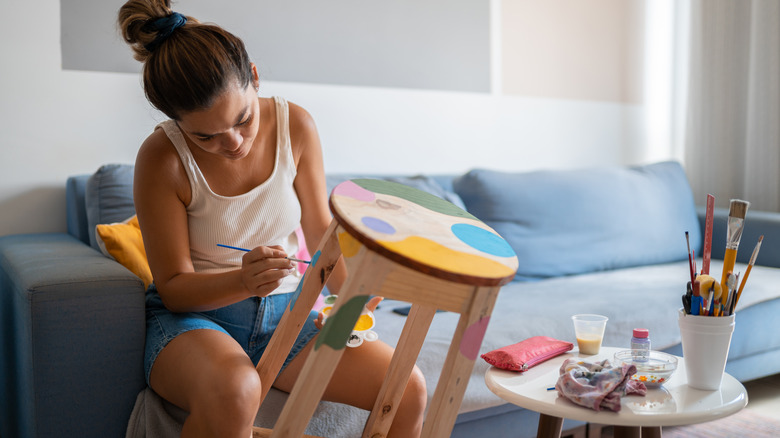This Common Kitchen Ingredient Can Subtly Change The Color Of Your Paint
Experimenting with lighter paint shades? Instead of spending money on white paint to lighten your pigments, grab a lemon from your kitchen. Lemon may become your favorite new art supply staple, as its acidic content produces a gentle lightening effect on water-soluble paints like watercolors without damaging the medium. The results are subtle but beautiful.
Lemons contain a high amount of citric acid, which acts as a natural bleach. Some people add lemon juice to laundry to brighten white clothing. You may have even heard of lemon juice being used to naturally lighten hair. When you add this common ingredient to paint, it works wonders. Lemon's ability to strip pigment will allow you to achieve a vintage, washed-out look on your painted crafts or lighter tones on your canvas.
You can also use lemon juice to fade paint on a variety of materials, including plaster, wood, and stone. Keep some lemons on hand when it's time to clean up, because you can also use them to easily clean and renew paint brushes. Let's get into the details of how to use this citrus fruit for your next painting project.
How to use lemon juice to produce lighter paint colors
Experimenting with lemon juice is best suited for watercolor paint. Watercolors are more translucent than acrylics and can be diluted more easily. The effects of the lemon may be more noticeable on watercolors, and unlike acrylics, watercolors do not become water resistant when they dry. The pigments can still be modified, meaning you can use lemon juice to lighten watercolors whether the paint is still wet or dried completely.
For the most noticeable results, apply your watercolors to the canvas and squeeze a few drops of a lemon wedge directly onto the paint while it is still wet. As the drops of lemon juice are absorbed, the colors immediately begin to fade, creating a soft, washed-out result once the paint is dry. You may also notice that the lemon juice dries in unique, sunburst-like shapes. For a more precise approach, try spreading the lemon juice around the canvas with a paint brush or sponge pad.
Watercolors are versatile and can be used to paint a variety of materials, including air-dry clay, fabrics, stone, wood, and various types of paper. This makes it possible to use lemon juice to lighten the pigment on any of these surfaces. However, watercolors may produce very different results on unconventional surfaces, which means the effects of the lemon will vary. Plus, the fading effect may not be as noticeable on larger projects. The safest approach is to test it on an extra scrap of material or in an inconspicuous area before going all in.
